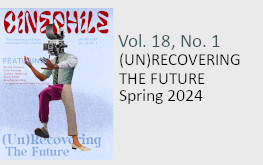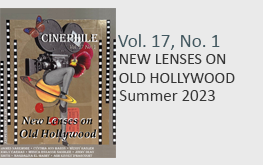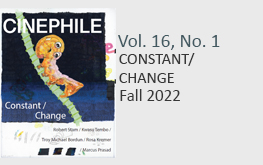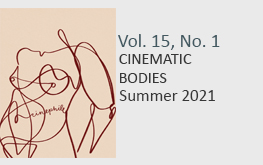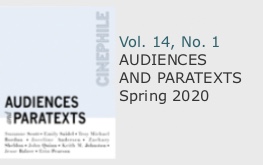Larrie Dudenhoeffer
There was a line/there was a formula;
Sharp as a knife/facts cut a hole in us
-Talking Heads, “Crosseyed and Painless”
Other critics discuss the theme of voyeurism in Alfred Hitchcock’s 1954 Rear Window (Modleski 73; Mulvey 31; Samuels 112-14), but few of them mention the specular figuration of the film’s mise-en-scène.[1] In the film, voyeur L.B. Jeffries (James Stewart) comes to suspect salesman Lars Thorwald (Raymond Burr) of murdering his sickly wife Anna (Irene Winston). From a wheelchair, Jeffries watches for evidence of the murder from the two windows looking into the Thorwalds’ Greenwich Village apartment. “Jeff,” resting up after fracturing his leg, whiles away the time spying on his neighbors, and ultimately convinces his fashion-conscious fiancée Lisa Fremont (Grace Kelly) to investigate the Thorwalds’ apartment after suspecting Lars of covering up Anna’s murder there.[2] Lars catches Lisa in the act, even though she escapes after a few officers show up to question the two of them. Thorwald nevertheless follows Lisa’s signals and triangulates the eye-line into Jeff’s apartment.[3] He shows up there to confront Jeff, who fires off camera flashbulbs to disorient the murderer until the officers once again come to the rescue. Although this climactic moment in the film deserves the critical attention it gets,[4] a few earlier scenes more neatly capture the scopic regime of the film’s viewers and characters, one that suggests that ‘having a bad wheel’, at least in a Lacanian sense, refers to the relative incapacitation of their eyes (or I’s) rather than their legs. The two windows of Thorwald’s apartment mirror the viewer’s and Jeff’s eyes-Jeff even uses binoculars and a telephoto lens over the course of the narrative to examine the murder scene more closely. Later in the film, Hitchcock’s camera comes to focus straightaway on one window or the other, so that these ‘eyes’ function independently of each other in a way that resembles the ocular dysfunction of strabismus. This condition reflects the splitting of the film’s scopic register: one eye trains straightforwardly on the film’s narrative moves, character identities, and other readable elements, and the other inwardly on the unconscionable desires, fantasies, and ego-shattering enjoyment that at once drive and resist such profilmic representation.
The scene in Rear Window that most formally allegorizes this type of splitting features Jeff and visiting therapist Stella (Thelma Ritter) fantasizing signs of Anna’s murder from a first-person perspective and then figuring them into the otherwise commonplace activity of Thorwald’s apartment. Two important similarly voyeuristic moments in the film set up this scene: one in which Jeff spies on the Thorwalds’ acrimonious relationship and another in which Jeff watches Lars suspiciously dispose of some sharp instruments. These moments enable us to rework the relation of the Lacanian subject of the unconscious to the symbolic order so as to ‘set up’ a discussion of Jeff, Lisa, Stella, and the viewer’s fantasmatic crossing over into the scene of the crime.

Technically, strabismus refers to the “crossing of the eyes,” a misalignment affecting their directional axes: in its alternating variety, the subject can fixate only with one eye and then the other, with the “straight” eye functioning and the other not (Anderson 1636). Rear Window‘s monocular fixation on one or another window in its mise-en-scène resembles this condition, and moreover Jacques Lacan’s notion of the Spaltung or “split subject.” In “The Instance of the Letter in the Unconscious,” Lacan revises cogito ergo sum to account for the unconscious’ relation to the structures of language: “What we must say is: I am not, where I am the plaything of my thought; I think about what I am where I do not think I am thinking” (157). Subjectivity, for Lacan, does not translate into intellection or consciousness. The subject rather transitions from the real to the symbolic register: from a state of immediacy, indeterminacy, and “completeness” that remains outside of speech, individuation, and consciousness-all of which requiring difference-to the accession to this difference in the form of sociolinguistic representation (Ecrits 42, 64). Lacan thus argues that “when the subject appears somewhere as meaning, he is manifested elsewhere as ‘fading’, as disappearance” (Four Concepts 218). The transition from the real-“vanishing being” (Ecrits 64)-to meaning in the symbolic order inscribes the division of the subject. Lacan describes as aphanisis this movement in which the signifier alienates the subject from the non-conscious state of simply being. The real, the name for this absolute state, resists symbolic capture, determines the limits of conceptualization, and reemerges in those encounters traumatic to subjective consciousness. Lacan diagrams the set of exchanges under which these terms function; this diagram (figure 1) coincidentally resembles a set of ‘eyes’ that refuse to cooperate with each other (Ecrits 67; Four Concepts 188).
Lacan couches the subject’s relation to the Other-the field of language-in false terms of choice, since existentially the subject must ‘make sense’ in order to develop recognizably into a human being with an unconscious, or someone whose representations do not neatly square with its desires, fantasies, and somatic impulses :
[We] are dealing with […] the being of the subject, that which is there beneath the meaning. If we choose being, the subject disappears, it eludes us, it falls into non-meaning. If we choose meaning, the meaning survives only deprived of that part of non-meaning that is, strictly speaking, that which constitutes in the realization of the subject the unconscious. (Four Concepts 211)
The real thus survives in the subject’s unconscious, straddling the division of Being and Meaning. The unconscious, developing out of this division, thus resembles the differential structure of representation, while at the same time opening onto the real as its “ultimately unknown” centre, as the “gap” that enables the discrimination of forms (e.g., the spaces in in-between-ness), makes immediate self-relation impossible, and thus splits the thinking subject into its own other (Four Concepts 22-23). The real and the symbolic, in a sense, ‘look’ in on each other in Lacan’s diagram, in a way that figures the esotropic form of strabismus, in which one eye wanders towards the other/Other.
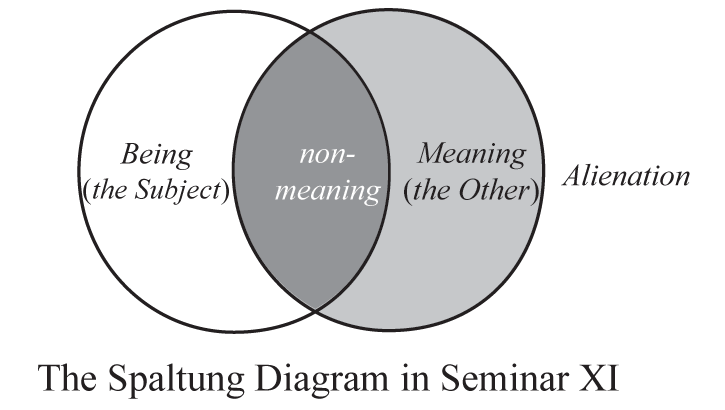
The windows of Lars Thorwald’s apartment in Rear Window correspond to the circles in Lacan’s diagram. The two left windows, corresponding to the circle that circumscribes Being, frame Thorwald’s kitchen and living room. Anika Lemaire describes Being as “lived experience” (51-52), an approximation of these ‘living’ or ‘lived-in’ rooms. Lacan moreover, situates traces of the real in the semantics of the unconscious and the irregularities of language (Ecrits 12, 55, 80). These diagrammatic terms inform the first set-up of Jeff, Lisa, and Stella’s reconstruction of the murder scene. The camera, ostensibly from Jeff’s apartment window, follows Thorwald carrying Anna’s dinner into the bedroom; the film cuts to Jeff watching them and then to the couple as Anna derisively tosses away the flower Lars offers her. The film then cuts to another shot of Jeff, now intent on their interaction, and once more to a shot of the two windows and the drainpipe separating them. In the living room, Thorwald uses a telephone to speak to someone, maybe a mistress; this room thus represents the voice of the Other in the unconscious, the aggression we must repress in the infans stages of development (24), since Thorwald might be colluding with this someone to murder his wife.
The right window, corresponding to the circle that circumscribes Meaning, frames the Thorwalds’ bedroom, in which Anna convalesces. She moves towards the left, though, to eavesdrop on Lars’s telephone conversations-to follow the voice of the Other-and then mocks Lars in the bedroom, sublimating into symbolic expression the deadly tensions in this scene. Lacan abstracts the sexual drive from the other drives, situating it in the circle that designates Meaning, the demands of culture that “dissolve” the sexual drive into symbolic structures like marriage (Four Concepts 189). The bedroom, the usual site of sexual relations, also functions as the locus of the Other: Anna Thorwald, seen from the right window corresponding to Meaning, assimilates the implications of Lars’s telephone conversation into the schemas of understanding, narrative impetus, and symbolic conclusion (39). The camera following them focuses on the two windows in a way that suggests a functional, cooperative set of eyes; that types the marital turbulence Jeff, Hitchcock, and the viewer see as normative, even dismissible; and that suggests the opening and closing of the unconscious in the interaction of the drives circulating like telephone currents in the left circle and their symbolic codification-akin to marriage-in the right circle, Lacan seeing “support” for the sexual drive in this split (198-99).
The annex connecting the rooms and the events that transpire in that space remain offscreen, behind the drainpipe, in a non-interpretable gap out of which nevertheless comes new expectations and new significations. The annex thus corresponds to the interstice of non-meaning in the diagram, where Lacan argues ‘truth’ awaits its realization in the Other (33, 129). For example, Lars, when disappearing into this area, disappears for a moment from the diegesis, only to reemerge with new significance in the window that designates Meaning. Anna’s reaction there in that room signifies Lars’s infidelity and offers Jeff the chance to thereafter construct a narrative motive for Anna’s murder. Anna, rising from the mattress, touches non-meaning like a dreamer, then comes to terms, again in the area of Meaning, with the ‘truth’ about Lars’s conversations.
Moreover, the drainpipe intersecting the bedroom and living room windows effectively signifies the splitting of the marriage. It also signifies, though, the division of the subject into the “lived experience” of Being and the social “I” of Meaning, which Lacan terms the Spaltung in order to represent it as $ algebraically (Ecrits 301). The drainpipe resembles the slash in this symbol, dis-unifying the scene, the narrative action within it, and the fantasmatic/ratiocinative investments of the subjects watching it, whether L.B. Jeffries, Lisa Fremont, or Rear Window‘s audience. The drainpipe and windows also figure as a face,[5] with the drainpipe representing the nose and the windows the eyes. The camera’s alternation from one window to the other thus afflicts an esotropic sort of strabismus on Jeff and the viewer, who, like Anna, turn an eye inward on the real, a traumatic move that compels the saccadic retreat to the symbolic and threatens the collapse, absenting, or ‘murder’ of their subjectivity.
In this first exchange, the ‘fovea’ of the camera thus starts to misalign, at first concentrating more on the window corresponding to Meaning.[6] Lars waves Anna away when she laughs at him, a sublimation of a murderous impulse, and one that foreshadows Anna’s narrative effacement. When Jeff falls asleep, we thus see the windows darkening-much like the darkening of Jeff’s eyes-which signifies Anna’s murder and suggests a radical alteration of the film’s mise-en-scène in the camera’s strabismus-like torsions. In another important set-up to the investigation of the crime scene, the film shows Jeff in a medium shot sitting at the window, watching Thorwald’s actions, first through binoculars and then through a telephoto camera. He sees the left windows open, with Thorwald closing an attaché case full of Anna’s valuables, moving into the kitchen to wrap a saw and butcher knife in newspaper, and returning to the living room to relax. The film cuts to Thorwald stretching, ready to take a nap, and then to the anxious cast of Jeff’s face, eyes darting in close-up once more to the left.
These images represent more than the tuche, the encounter with the real, which remains inassimilable to consciousness (Four Concepts 53, 55). The matheme $, we must remember, marks the symbolic castration/sexuation of the subject, who “cannot be wholly represented in the Other” (25). The cut identifies the real with this ontic remainder; at the same time, it compels the subject to fantasize a text that tries to compensate for the Other’s failure to capture this remainder (26). Rear Window darkens Anna’s representational status while at the same time reframes it as a mystery for Jeff, Lisa, Stella, and the audience to solve. The tuche coincides with the entextuation of Anna’s fate, since these characters, in order to fill in this gap in their understanding (Lisa: “What’s a logical explanation for a woman taking a trip with no luggage?”), must tap into that necessarily missing element in the Other, the ego-convulsing sense of murderous enjoyment[7] (Jeff: “That […] where she was going she wouldn’t need any luggage”). If castration sets the conditions for suspense, with one word or image anticipating another that might complete its meaning, it also motions towards the suspension of the Other in the subject’s encounter with that radical otherness that is the real.[8] These images thus suggest the overwhelming of the symbolic, the cleansing of evidence-i.e., a repertoire of signifiers-and the concealment of implements of castration, a metaphor integral to Lacan’s theorization of a split subject. The father imago frustrates the infant’s incestuous desire for unification with the mother; the infant develops an unconscious when it internalizes this imago as the line separating the real from Meaning in the subjective condition (Ecrits 276; Lemaire 82-83). If the film remaps this structure of castration, why, we might ask, do two windows overlap with the circle designating Being in Lacan’s diagram, whereas only one window overlaps with Meaning? And why do the images in them signify murder rather than overwhelm signification outright? An answer to the first objection must mention the two registers that anticipate Meaning in the symbolic: the real, which speculatively antecedes ‘castration’ and corresponds to the kitchen window, where implements of castration ‘vanish’, and the imaginary, which exteriorizes the ‘I’ in the subject’s misrecognition of itself in its mirror image (Ecrits 3, 17, 23) and corresponds to the living room window through which Lars later catches Jeff looking at him, much as the subject and its mirror-image ‘look’ at each other.
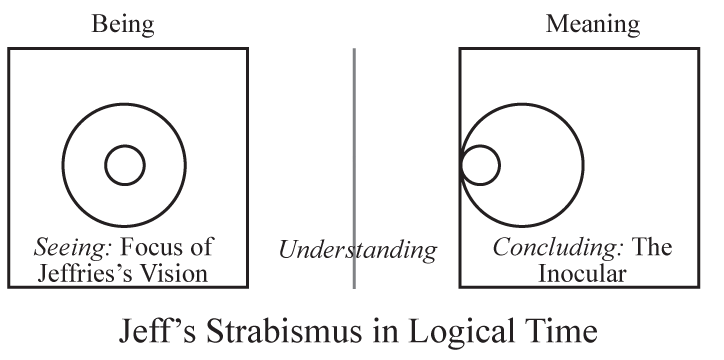
As for the second objection, the images in the windows corresponding to Being momentarily disrupt the film’s diegetic continuity and intelligibility, so that theorists like Lee Edelman and Robert Samuels can argue that Thorwald triggers Jeff’s erotic connection to other men or unconscious desire to “cut” Lisa Fremont (Edelman, 91-92; Samuels 114-15).[9] For example, when Lisa calls Jeff “diseased” about five more minutes into the film, she does not do so merely to revile his fantasies or voyeuristic tendencies-she rather cautions against Jeff’s and Thorwald’s strabismus-like focus on the windows corresponding to Being, or that which remains anterior and threatening to the speaking subject. She thus makes troublesome a fixation that revisits the specular-aggressive dialectic of the mirror’s captation of this subject (Ecrits 20, 199).[10] In short, the saws Jeff and the viewer see threaten their disarticulation. Jeff, fixating on the left-side of Thorwald’s apartment after using a telephoto camera to scrutinize it, deranges the image of ordinary tools and utensils into something ‘wrong’. He switches to binoculars to watch Thorwald enter the bedroom. At the moment of this transition into Meaning, Jeff starts to translate the images we earlier saw into symbols, into narrative elements, a telegraphing of the movement of “things” into signification across the divide of non-meaning or the unconscious (Four Concepts 22–23). He even manages to convince Lisa of the murder, although not without some resistance, since their relationship, much as with the Thorwalds’ own, is fraught with tensions and subtle cruelties.[11] Lisa wants to talk about marriage and the future, finding Jeff’s fascination with someone else whose relationship appears finished totally frustrating:
Lisa: There’s nothing to see!
Jeff: There is something! I’ve seen it through that window. I’ve seen bickering and family quarrels and mysterious trips at night and knives and saws and ropes and not since last evening a sign of the wife. All right, now you tell me where she is.
After this exchange, Lisa and Jeff watch Thorwald securing a large trunk with these “ropes.” This image in the context of Jeff’s speculations comes to mean “something” to Lisa, who treats the situation analytically: “Let’s start from the beginning, Jeff. Tell me everything you saw and what you think it means.” Unlike Jeff earlier, Lisa and the viewer fixate on the right window, with the images Jeff saw in the site of Being falling into the discourse of the Other. In fact, Lisa must fixate on Meaning, since she must take Jeff’s ‘word for it’, remaining outside the visual experience of the violence of the real that the left-side windows frame. After Lisa departs, Jeff’s and the camera’s focus on the living room window substitute for an esotropic ‘crossing of the eyes’ in Lacan’s diagram: Jeff looks straight with one eye at the window corresponding to Being, and inward with the other eye, for the moment collapsing Meaning from the seen/scene and thus, all while touching a telephone receiver, courting destruction, much like Mrs. Thorwald, the last character to listen in on one of Lars’s telephone conversations. Jeff, though, who earlier tells Lisa that attractive women “just [have] to be,“ may also want to maneuver Lisa into the circle that designates Being, so as to cut off discussion of the marriage symbolism that Lisa favors and disintegrate the alienating sexual differences, inimical to a real sense of ‘completeness’, that Jeff’s erectile cast and Lisa’s voguish fashions accentuate for the viewer.
These exchanges comprise “the whole set-up,” to use Jeff’s words, to a scene that underlines the film’s representation of its own strabismal visual regime and also its fairly thorough re-envisioning of Lacan’s Seminar XI diagram. This scene follows two delivery men who, after moving across the kitchen and living room, take the trunk in the bedroom that, Jeff assumes, contains Anna’s corpse. The scene then cuts to a shot of Thorwald signing a form in the window corresponding to Meaning, thus to the mediation, normalcy, and social commerce of word-representations. Hitchcock films these men’s movement using an iris, a curious choice since Jeff watches them through binoculars, not the single eye of the telephoto camera. The iris must therefore suggest the monocular fixation characteristic of strabismus, as Jeff’s ‘iris’ vision-maybe Jeff’s unconscious-ineluctably strays once more to the left window. The film then cuts to Jeff and Stella, the two of them staring in the direction of the right window of Thorwald’s apartment. After setting down the binoculars, though, Jeff subtly cocks one eye once again towards the left side of the apartment. The circle of Meaning for Jeff malfunctions, collapsing strabismus-like into the circle of Being. The wall[12] of the apartment complex across from Jeff’s own window maps this splitting of vision over the film’s mise-en-scène so as to recode in “logical time” the terms of Lacan’s diagram and the dynamics of cinematographic voyeurism (figure 2).
This notion of logical time anatomizes the movement of Jeff’s vision and its alternating fixation on the left or right windows in the film (Four Concepts 39-40). Jeff first sees into the windows corresponding to Being, the ‘things’ in them without signification until Jeff moves from the intermediate non-meaning of understanding-the combination of these ‘things’, their inconclusiveness (32), and the assumptions Jeff fills them with-to Jeff’s concluding that these ‘things’ must mean, must insist on some narrative relevance. This last operation thus seems inocular[13] in light of Jeff’s strabismus: It describes the ‘right eye’s’ attention to the unthinkable of the real, so that it cannot see straight or normally at times; and it also describes the transformation of the ‘things’ Jeff sees into symbolic representation, into the narrative facts, never actually seen, of Anna’s murder in Jeff, Stella, Lisa, and the viewer’s conscious reconstruction of it.
These characters suffer the molestation of the real that comes of a dangerous fascination with it, one that tampers with our fovea, distorting Rear Window‘s mise-en-scène and its imaging of the split subject. The film’s denouement shows Jeff wearing two casts now, having fallen out of his apartment window in a climactic encounter with Thorwald. Lisa reads a fashion magazine while Jeff sleeps, confirming all at once their sexual distinctiveness, their alienation from Being in the symbolic, and their alienation from each other. Jeff sleeps for the moment, circumscribed in non-meaning, although still on the verge, in a sense, remaining close to Lisa, who represents marital impulses tending towards symbolic union or the securing of fragmentary things into meaningful code-structures. This union romanticizes the un-differentiation of the real, which, as Jeff’s near-undoing suggests, emerges throughout the film as traumatic, impossible to consciously revisit, and resistant to a straightforward conceptualization (Four Concepts 51, 166-67). The viewer thus experiences with Jeff the strabismus of the film’s sequencing, which returns our attention to the Spaltung, reminding us of the ‘real facts’, the cut in the subject that compromises self-knowledge, social interaction, and our own shifty fantasies about what it is that we actually think we are seeing.
Notes
[1] In “Visual Pleasure and Narrative Cinema,” Mulvey famously argues that Rear Window compels viewer identification with the “voyeuristic situation” of the film’s main character. The film thus turns Lisa Fremont, its female sex interest, into an exhibitionist subject to male fetishization, scopic control, and sadistic interpellation as “wrong” (31). Modleski re-elaborates this thesis, suggesting that such interpretations require women’s assent, meaning that Lisa comes to represent the female spectator “in masculine drag,” complicit in reaffirming androcentric worldviews (84). Samuels finds these visual structures more narcissistic than voyeuristic. He redirects male identification towards the murderer’s wife in the film so as to make room for the expression and disavowal of same-sex desire (116-7). However, according to Howe, the murderer displaces Hitchcock’s audience awareness: “Having our look returned makes us aware of our own voyeurism” (34). Hitchcock’s mobile camerawork, unlike Jeffries’s unidirectional own, teaches the viewer an appreciation of “being-for-others” and the concomitant dangers of social isolation (33-4). These theories, while quite analytically rich, do not address the splitting of the scopic regime in the film: the non-coincidence of the viewer’s and the characters’ conscious detective work with their unrepresentable desire for the real, for the impossible to occur to them.
[2] Jeffries calls the other characters “Lisa” and “Thorwald” in the film; conversely, Lisa shortens Jeffries to “Jeff.” We will thus follow the film’s nomenclature for these characters.
[3] Manlove, in an essay that comes full circle once again to Mulvey, argues that Lisa, the object of visual desire in the film, veils the real, Lacan’s term for egoic dissolution. This desire leaves a stain that threatens Jeff and Lisa with destruction in allowing the murderer to trace it to its specular sources (96-9).
[4] For example, Harris argues that Jeffries, in imposing “fantasy on reality” throughout the film, seriously endangers others as “he becomes increasingly enveloped by his sickness” (60). In Seminar XI, though, Lacan argues that the real supports fantasy, which in turn “protects the real” (41), while fantasy, not objectal reality, supports desire (185-6). The left windows of Thorwald’s apartment do not visualize Jeff’s sick fantasies or a ratiocinative set of data so much as allegorize the impossible support of desire, thus fracturing and recasting the viewer’s own scopic drives in watching Rear Window. In short, these windows trace the impossible of the real, the eye-line of our own unrepresentable enjoyment ricocheting from the suspicious activities seen in the left side windows of the apartment.
[5] Rear Window focuses these shots on the living room and bedroom windows, while for the most part, excluding visual access to the kitchen window. Similarly, Lacan situates the real outside of our experiences in the imaginary and symbolic orders (Four Concepts 280).
[6] Jeffries’s/Hitchcock’s camera of course extends, refocuses, and mediates the subject’s range of vision, even as it cannot see what it really wants to see: the desire that at once structures the ‘readouts’ of this vision and threatens ‘to screw’ with the subject’s scopic universe-to turn on the non-presence of the subject’s desire within this universe. See Copjec on the “trap” of the Lacanian gaze in “The Orthopsychic Subject: Film Theory and the Reception of Lacan”:
The subject is thus conceived as split from its desire, and desire
itself is conceived as something-precisely-unrealized […] The subject, in short, cannot be located or locate itself at the point of the gaze, since this point marks, on the contrary, its very annihil- ation. At the moment the gaze is discerned, the image, the entire visual field, takes on a terrifying alterity. (294, 300)
In other words, looking out for murder implicates the eye desire-wise in looking forward to its own self-destruction, to being part of rather than symbolically mastering what it sees.
[7] As Stella tellingly says to Lisa in another scene, “Nobody ever invented a polite word for a killin’ yet.”
[8] To misquote Georges Bataille a little, “if [Thorwald] is in the end only our own madness, if we come to tears, if we shudder in sorrow-or if we are seized by fits of laughter-can we fail to perceive […] the preoccupation with, the haunting fear of death” (23)?
[9] Edelman associates the real with the anal compulsion that “stands behind” the symbolic order, arguing that Rear Window tries to squeeze Lisa and Anna out of its narrative as markers of castration so as to fantasmatically return Jeffries to the sexual freedom of “anal formlessness” (92). However, Samuels rethinks this same-sex desire in the film, contending that Jeffries aspires to a sexual “compromise formation,” secretly wanting “a man and a woman” (115). Jeff must therefore re-imagine Lisa in non-castratory terms. These theorists refocus the viewer on the nonsense rather than the meaningfulness of sexual desire. If it seems nonsense, though, to claim that a medium cannot represent its own characters’ self-annihilating desire, we must remember that desire wants the impossible, and the impossible occurs to us only as an effect of speech, even as we find that with it we can never say what ‘it is’ that we want.
[10] Lacan argues that the mirror imago of the infant “manifests the affective dynamism” through which it develops its characteristic “inner conflictual tension,” meaning that the imago at once offers it a gestalt representation of its discrete form and intensifies the distress resulting from the “intra-organic and relational discordance” of its first six months (20-1). The mirror splits the infant along the real and symbolic registers, a splitting and an overlapping thus describable as a sort of “ambivalent aggressiveness” (21). Elsewhere, Lacan conjectures that a patient of his who enjoys sticking his feet out of the window-somewhat like Jeffries, with one foot stuck straight out in a cast-must therefore take an interest in the imaginary “direction of his birth” (199).
[11] Lisa complains, “Something’s wrong with me,” when talking about Jeff’s romantic inattention. Thinking about something else, Jeff carelessly remarks, “Just how would you start to cut up a human body?” This moment in the film identifies Jeff’s fantasies with Thorwald’s suspicious actions, and moreover suggests that the “something” that is “wrong” remains on this side of the speaking subject’s “me.” And Jeff observes that even Lisa finds it “pretty hard to keep away from that word-murder,” or that ecstatic something-or-other which even this word seems inadequate to.
[12] The last syllable of “Thorwald” sounds like “walled,” and Lacan argues that “the path of the subject passes between the two walls of the impossible” (Four Concepts 167), the tuche with the real in the unconscious and the “indifference” of the drives in their spiraling towards ego-shattering enjoyment (168). Thorwald thus moves across the two walls that separate his apartment’s kitchen, living room, and bedroom, and also the two walls that separate this apartment from Jeff’s own. ‘Walls’, of course, also describe the vagina, with one of its myths, the vagina dentata, signifying Anna’s earlier unmanning or ‘castration’ of Thorwald in the room corresponding to the circle of Meaning.
[13] “Inocular,” an almost forgotten term taken from the 1913 Webster’s Dictionary, refers to the insertion of something into the corner of the eye. For example, Jeff’s eyes see nothing intrinsically criminal in the right window of the Thorwalds’ apartment, even while these eyes stray fantasmatically to the left so as to ‘shed light’ on or rather insert a little of the vertiginously ‘dark’ real on visual data that otherwise seem relatively innocuous. More than a case of Freudian projection, then, Rear Window suggests that all interpretation does a certain amount of violence to what we see in front of us, thus in turn de-solidifying what we think of our environs, our neighbors, and ourselves.
Works Cited
Anderson, Douglas A., ed. Mosby’s Medical, Nursing, & Allied Health Dictionary. St. Louis: C. V. Mosby, 2002.
Bataille, Georges. The Tears of Eros. Trans. Peter Connor. San Francisco: City Lights Books, 1989.
Copjec, Joan. “The Orthopsychic Subject: Film Theory and the Reception of Lacan.” Feminism and Film. Ed. E. Ann Kaplan. New York: Oxford UP, 2000. 287-306.
Edelman, Lee. “Rear Window‘s Glasshole.” Out Takes: Essays on Queer Theory and Film. Ed. Ellis Hanson. Durham: Duke UP, 1999.
Harris, Thomas. “Rear Window and Blow-up: Hitchcock’s Straightforwardness vs. Antonioni’s Ambiguity.” Literature Film Quarterly 15 (1987): 60-3.
Howe, Lawrence. “Through the Looking Glass: Reflexivity, Reciprocality, and Defenestration in Hitchcock’s Rear Window.” College Literature 35 (2008): 16-37.
Lacan, Jacques. Ecrits: A Selection. Trans. Bruce Fink. New York: W.W. Norton, 2002.
–. The Seminar of Jacques Lacan Book XI: The Four Fundamental Concepts of Psychoanalysis. Trans. Alan Sheridan. New York: W.W. Norton, 1998.
Lemaire, Anika. Jacques Lacan. New York: Routledge, 1979.
Manlove, Clifford T. “Visual ‘Drive’ and Cinematic Narrative: Reading Gaze Theory in Lacan, Hitchcock, Mulvey.” Cinema Journal 46 (2007): 83-108.
Modleski, Tania. “The Master’s Dollhouse: Rear Window.” The Women Who Knew Too Much: Hitchcock and Feminist Theory. New York: Routledge, 1989. 74-85.
Mulvey, Laura. “Visual Pleasure and Narrative Cinema.” The Sexual Subject. New York: Routledge, 1992. 22-34.
Samuels, Robert. “Rear Window Ethics: Laura Mulvey and the Inverted Gaze.” Hitchcock’s Bi-Textuality: Lacan, Feminisms, and Queer Theory. Albany: State U of New York P, 1998. 109-121.


